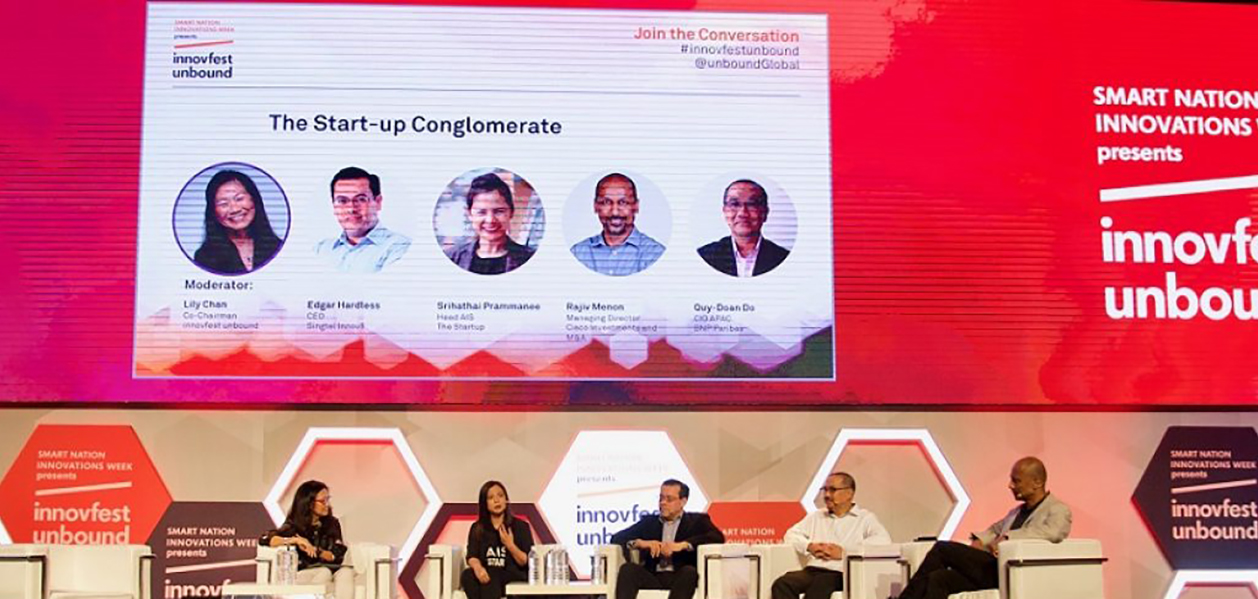The dance of start-ups and large corporations
By working closely with start-ups, bigger and more established companies can reap the benefits of open innovation, says a panel of experts at the innovfest unbound conference.
Size matters in business, but just as whales are not the only creatures in the ocean, small companies can co-exist and even complement large multinational corporations in sustaining growth and profitability. Finding that synergy between a fledgeling enterprise and a mature company can sometimes be tricky, but it may well be worth it, said a panel of experts at the innovfest unbound 2018 conference held at the Marina Bay Sands, Singapore.
“There is a realisation that a lot of the new technologies, new business models and new ideas are actually coming from the start-up ecosystem,” said Edgar Hardless, CEO of Singtel Innov8, who was a speaker on the panel discussion titled ‘The Start-up Conglomerate’.
Joining him on the panel were Quy-Doan Do, Chief Information Officer APAC of BNP Paribas; Rajiv Menon, Managing Director of Cisco Investments and M&A; and Srihathai Prammanee, Head of AIS The StartUp. Dr Lily Chan, Co-Chairman of innovfest unbound, moderated the session.
Securing future success through collaboration
In a climate of disruption, success favours the adaptable, and innovation is a key part of thriving on change. To Do of BNP Paribas, start-ups represent opportunities for big companies to leverage new inventions to improve their products and services. Hence, large corporations are beginning to accept that they are not the sole innovators in their respective sectors and are becoming more open to collaborations with external partners.
While there may be a temptation to fixate on innovations that are ‘trendy’ and cater to current market demands, there is also a need for companies to think about what capabilities could become relevant in the future, said the panellists. Underscoring this point, Menon cited drones and cybersecurity as examples of technologies that have very broad use cases going forward, making them worth exploring in the present.
“We invest in the present, but we also [want to be cognizant of] the next thing on the horizon,” he said.
Bridging the ‘cultural divide’
Collaborations and investments in meaningful innovation may be important for businesses, but barriers exist that hinder the smooth execution of these efforts in real life. Dr Chan highlighted the problem of a ‘cultural divide’ in terms of how things are done when unevenly-sized companies collaborate. The larger partner is generally more risk-averse and less nimble in its processes, she said, whereas the smaller start-up tends to be more comfortable with risk and highly agile. Reconciling the two natures can be a challenge.
Nonetheless, the panellists advised that both parties align their vision and agree on a common objective to cross this divide and move forward. “The most important thing is to share and communicate that common objective transparently to everyone,” said Prammanee, adding that instead of viewing the start-up as a separate company, the large company could treat the start-up as if it were its own business unit, working together to solve the same set of problems.
When two become one
Should the collaboration proceed well, the larger enterprise may even consider acquiring the start-up. From the start-up owner’s point of view, there are both benefits and risks of such an offer.
The most obvious upside to being acquired is access to resources—the start-up can potentially tap into the financial prowess and brand reputation of the acquiring company to bring their products and services to larger markets, said Hardless. But these perks come with caveats.
“I think you have to accept that you’re being acquired. If you're a small company being acquired by a larger one, you have to expect that life will change. You’re not necessarily going to have the same ultimate freedom you had to make all the decisions, [unlike when] you were an independent company,” he said. Owners of small enterprises should therefore weigh their options and decide whether or not they accept the terms of the acquisition.
Clearly, the dance of start-ups and bigger companies is a complex one. When well-choreographed, a win-win situation can be achieved such that all stakeholders come together harmoniously to innovate and co-create value. Should you require assistance in navigating the various models of collaboration and open innovation, reach out to IPI Singapore today.

